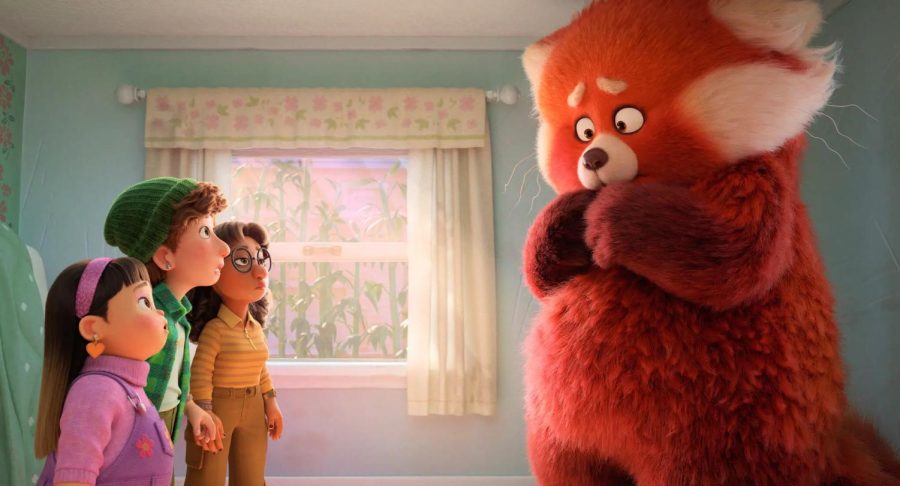Pixar’s new look through “Turning Red”
My panda, my choice: 13-year-old Meilin reveals her secret identity to her unsuspecting friend group.
April 18, 2022
“My panda, my choice,” 13-year-old Meilin Lee said following an argument with her mother regarding the fate of her red panda spirit. Marking an important shift away from formulaic Pixar stories, director of Pixar short “Bao” Domee Shi’s “Turning Red” stays true to its name with a bold theme of self discovery and autonomy through adolescence while simultaneously trying to live up to others’ expectations. While seemingly chaotic, the film does an excellent job capturing the stream of consciousness of an Asian teen experience.
Bubbly, spirited and well-received at school, Meilin Lee (Rosalie Chiang) has a supportive friend group, excels academically and takes pride in caring for family’s temple while seeking their validation. However, everything changes after an embarrassing incident with her mother Ming Lee (Sandra Oh). Meilin discovers that she transforms into a giant red panda whenever she expresses too much excitement or anger due to her family’s connection with an ancestor with a unique relationship with red pandas. Capturing the turmoil between a mother-and-daughter relationship, the film explores a childhood desire for independence while incorporating the difference in perspective that comes with age as Meilin’s red panda morph, friend group and desire to go to concerts create a rift between her and her mother.
Unlike typical coming-of-age movies, the film provides a full circle of understanding for the viewer. With the scene of Meilin comforting a younger version of her mother sobbing over a fight with Meilin’s grandmother (Wai Ching Ho) in a bamboo forest where members of the Lee family contemplate their red panda spirit, director Domee Shi highlights how Asian parent stereotypes are passed from generation to generation, an accurate revelation for many Asian Americans like myself. In this way, the film does well in going beyond the surface by addressing the reasons in which strained parent-daughter relationships within the Asian community may arise rather than moving forward with a cliche resolution that pretends that everything is okay.
Besides the storyline, each time any character experiences an outburst of emotion, it almost appears that they’ve been sucked into another dimension. With cherished 90s era anime like “Pokémon” and “Fruits Basket” as inspiration for animation style, Shi portrays positive emotion with puppy-dog eyes and pastel colors and shock often with the character looking like they’ve quite literally become Chucky. Instead of conforming with a Pixar-typical western animation style, Shi breaks ground by emphasizing the Asian-centered aspect of the film through the film’s cinematography as well, while also highlighting emotion in a way Pixar has never seen before.
Despite online criticism claiming that the film’s plot makes its audience “limiting” and the film “unrelatable,” aspects of Chinese culture regarding ancestry have already been simplified for viewers to understand. In the case that the film’s diversity may be bothering critics, they may as well opt to watch fairy tales like Cinderella instead. Tropes like overprotective parents with high expectations are relatable to many, regardless of their backgrounds.
As Pixar’s first Asian led film, “Turning Red” offered a refreshing change to see a familiar face as a bold main character with opinions, thoughts and experiences of her own, willing to let out a side her family wouldn’t approve of. Despite the Pixar cliché of a protagonist morphing into another being as seen in movies like “Soul,” “Turning Red” has definitely earned its spot as a future Pixar classic.
























































